Container Gantry Crane, 20', 40', 45' ISO Containers Cranes
Container transportation is a relatively recent technique of modern transportation. It provides the benefits of safety, efficiency, quality, speed, and economy. It is commonly utilized in cargo transportation for import and export. Solid bulk cargo and liquid bulk cargo account for nearly all transportation in the modern world. All kinds of goods have begun to be containerized, and container transportation has evolved into a high-efficiency method of transporting wolves.
Container terminal loading and unloading gantry cranes
Because of the increased demand for container yards and loading and unloading trucks, the loading and unloading process system may make good use of the yard and loading and unloading trucks to improve loading and unloading efficiency and expand the yard's passing capacity. The present container yard and loading and unloading technology includes gantry crane systems, trailer systems, straddle carrier systems, forklift systems, front hoist systems, and hybrid systems. The most common method is container gantry crane loading and unloading. The container loading and unloading bridge has been finished. Tire gantry cranes and rail gantry cranes are two types of container gantry cranes, frequently used in ports and yards for container handling and large and heavy objects handling.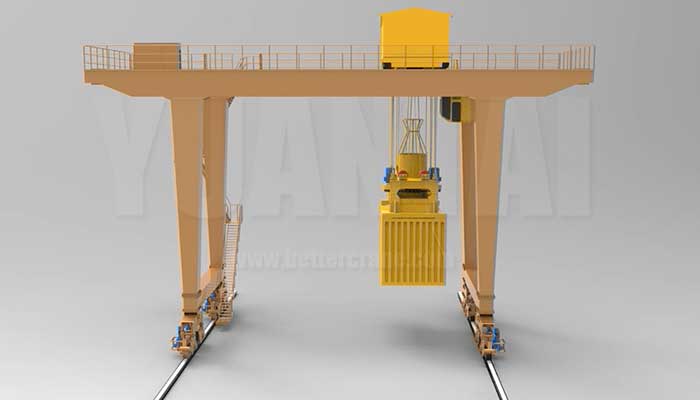
Rubber tired container gantry crane
The rubber tired gantry crane , also know as transtainer,is a kind of specialized gantry cranes used in large container yards and container terminals for standard container loading and unloading.
The tire type container gantry crane yard operation system was highly regarded internationally at the start of the development of specialized container terminals in China. As a result, most container terminals have long adopted this technique of public welfare.
The tire gantry crane system has the benefit of being able to effectively utilize the yard, having a low construction cost, being relatively simple to operate, and having mature equipment maintenance and management technology. The linear walking automatic control device can be used to achieve automatic control of the walking track and is connected to the computer system, making it simple to implement yard automation.
The downside is that, as compared to the straddle carrier system, the benefit must be reversed because the flexibility is insufficient and the carrying operation is challenging. Internal combustion power systems, which have significant energy and equipment maintenance costs and are very harmful to the environment, are used by tire-type gantry cranes.
- Tire-type container gantry cranes (also known as field bridges or tire cranes) are specialized machines used to load and unload standard containers at large-scale specialized container yards. It is appropriate not only for container terminal yards, but also for dedicated container yards.
- The rated lifting weight of fishing tackle is often 40.5t, 50t, or 60t, with a no-load lifting speed of 40-50m/min and a full-load lifting speed of 20-26m/min. The trolley travels at 70m/min, whereas the cart travels at 90-135m/min.
- The frame is supported by big, tubeless tires on four, eight, or sixteen wheels. The number of wheels is chosen based on the site's wheel pressure requirements. The cart's propulsion system can be either four-wheel drive or two-wheel drive. A manual correction mechanism and a four-corner anti-collision device are supplied to prevent collisions between the bridges and between the bridges and the containers.
- The trolley's operating mechanism uses a rack-type or four-wheel and two-wheel drive, and it runs smoothly. The driver controls the entire crane from the cab, which is located beneath the tiny frame. The speed control system works with either AC or DC power, has good speed regulation and consistent power management, and can automatically adjust the lifting speed based on the weight inside the box.
- Overload prevention, overspeed protection, high water temperature and low oil pressure, and other safety features are available. The wind speed is only one, and each mechanism has its own anti-typhoon anchoring system, emergency stop button, limit switch, and signal indication.
A gantry crane is an excellent choice for moving and stacking containers with high efficiency and safety. It runs along the track, lifting and stacking containers within the container yard's specified range. AC frequency conversion is used to control the lifting mechanism, trolley mechanism, and crane traveling mechanism. The hoisting mechanism is typically designed as a single drum, but it can also be designed as a double drum as needed.
Rail gantry crane system (RMG)
Rail mounted gantry cranes are used in container terminals for container loading and unloading as well as stacking.
To satisfy the needs of container transportation development, all ports in the port have renovated and built new container terminals in recent years. They've started adapting the application to high-density storage and large-scale orbiting container gantry crane yards with wider application and high-tech space. One of the choices is to prevent the work process.
The benefits of this system are increased yard use, a very basic mechanical structure, low maintenance, dependable operation, electric driving, energy conservation, and pollution reduction. Job automation is made simple by computer control.
The downside is that it has a restricted operating range and poor mobility because it can only be operated along the track. Loading and unloading trucks, as well as reversing operations, are problematic because to the huge span. The initial investment is substantial, and it is influenced by the power supply.
The girder, rigid and flexible legs, tiny trolley, hoisting mechanism, crane running mechanism, electrical system, and control room comprise the container handling gantry crane. The rail mounted gantry crane can be modified into single or double cantilever cranes based on application demands by extending the cantilever, double cantilever, or without cantilever, depending on the container handling process and the type of container handling vehicle (truck or brain).
Features of rail mounted container gantry cranes
- Rail mounted and rail traveling container gantry crane (also known as rail crane) is another type of specialized equipment for container yards. It is powered by mains electricity and moves over the track via the wheels. It is outfitted with 20' and 40' retractable spreaders (as needed). It can be outfitted with double box spreaders) to lift and stack containers within a given container yard range.
- The RMG's typical parameters are as follows: The gauge distance is 23m; the rated lifting weight under the fishing tackle is 40t; the full-load lifting speed is 23-30m/min, the no-load lifting speed is 46-60m/min; the trolley running speed is 63-70m/min; the cart running speed is 50-120m/min; and it can be extended or not. A hoisting mechanism, a trolley running mechanism, a cart running mechanism, and a rocking mechanism are all part of the machine.
- The hoisting, big car, and automobile mechanism are generally controlled by AC frequency conversion. The hoisting mechanism is typically a single reel, but it can alternatively be configured as a double reel open type if needed.
The terminal capacity, collection and distribution mode, terminal land area, process layout, technological advancement, environmental protection performance, safety and reliability, investment cost, and operating cost must all be taken into account when selecting yard operation technology and equipment. Although RTG and RMG have advantages and disadvantages, these shortcomings are constantly improving as technology advances. The port cannot focus just on the technique of operation, nor can it pursue the initial investment while ignoring the overall picture. The long-term development of the terminal should be based on a thorough examination of the insurance kinds of the respective terminals, as well as a deliberate and sensible selection with a realistic attitude.

The specific container spreader on container gantry cranes makes them suited for lifting 20-, 40-, and 45-foot international standard containers. A wide range of applications, excellent mobility, great production efficiency, and low susceptibility to ground inequality.
The purpose of the container gantry crane is to increase the effectiveness of container yard operations. A container trailer transports the containers, and it is in charge of stacking, loading, and unloading them. Rail mounted gantry cranes and rubber-tired gantry cranes are the two primary types of standard container gantry cranes.
Rail mounted container gantry crane parameters:
- Load capacity : 30-50t
- Span: 18-35m
- Lifting height: 12.3-21m
- Lifting speed: 9.2-12.5m/min
- Trolley running speed: 45-56m/min
- Crane running speed: 42-50m/min
- Work duty: A6-A8
Advantages of RMG container gantry crane
- High yard use; electric drive; pollution reduction;
- relatively simple mechanical design
- Reliable operation and simple upkeep
- The automation of yard activities can be accomplished via computer control.
Main structure of container gantry crane
Lifting mechanism
Electric motor, disc brake, reducer, and duplex drum are the main parts and components of the lifting mechanism of container cranes.
An AC motor powers the wire rope drum lifting mechanism, and a closed spiral gear reduction box powers a single-layer rope groove drum that winds the rope. The motor has enough power to provide effective acceleration.
Between the hoisting motor and the reduction box, there is an elastic coupling with a brake disc. The brake is a hydraulic push rod disc brake, which is released by a spring brake push rod.
An overspeed switch is provided on the high-speed shaft end of the hoisting mechanism. The complete machine stops in an emergency when the motor speed surpasses 115% of its rated speed.
The rated load indicator light in the driver's cab flashes when the load under the spreader is between 100% and 110% of the rated load, as determined by the weight sensor. The buzzer sounds a warning, the overload indicator flashes, and the PLC stops the lifting mechanism from raising any higher while allowing the lifting speed limit to lessen the weight when the load beneath the spreader reaches 110% of the rated load.
Trolley travelling mechanism
A wheel set, a motor, a reducer, a brake, a coupling, and so on comprise the trolley running mechanism, or a three-in-one reducer and a guide wheel set.
Crane travelling mechanism
The primary components of the container gantry crane's traveling mechanism include a three-in-one reducer drive, a rail clamp, a buffer, a wheel clamp, etc.
Features of container gantry crane
- The RMG Container Gantry Crane is designed and produced in line with national and industry standards, such as GB/T14406 "General Gantry Cranes" and GB/T3811 "Crane Design Specification".
- U-shaped gantry cranes are frequently employed in open areas, such as the front yard of cargo loading and unloading, transportation, and stacking operations for large-tonnage wharf heavy cargo and container berth ships.
- The crane is track-type, double cantilever, uses U-shaped support legs for the gantry, turns the upper portion of the hoisting trolley, and uses an electric telescopic spreader for containers.
Components of container gantry cranes
Gantry frame

The crane's main body and primary force-bearing element is the gantry frame. The main beams, support legs, end beams, lower beams, the cab, the walking platform, the railings, the ladders, and various auxiliary metal structures make up this structure, with adequate stiffness, stability, and strength. The primary components of container gantry crane frame refers to the metal structures like main beams, support legs, and trolley frames, etc.
Lifting trolley
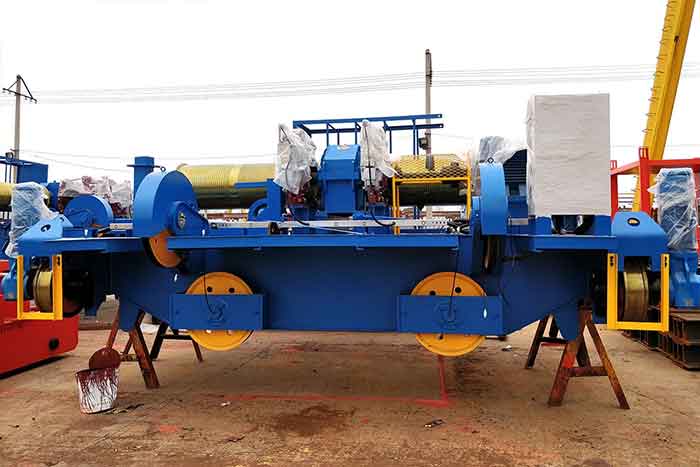
The hoisting mechanism, the trolley running mechanism, and the trolley frame make up its structure. The main frame of the trolley is a box-shaped, welded framework that has a built-in trolley rain shed. Additionally, the frame has safety features such stoppers, rail clearers, buffers, and operational limitations. A lifting weight limiter, a weight display feature, and a number of safety protection interlock switches are all included in the lifting mechanism. To prevent some wheels from being overloaded, the wheel diameter and material are chosen based on the maximum supporting force of the wheel under the most adverse situations.
Trolley operating mechanism
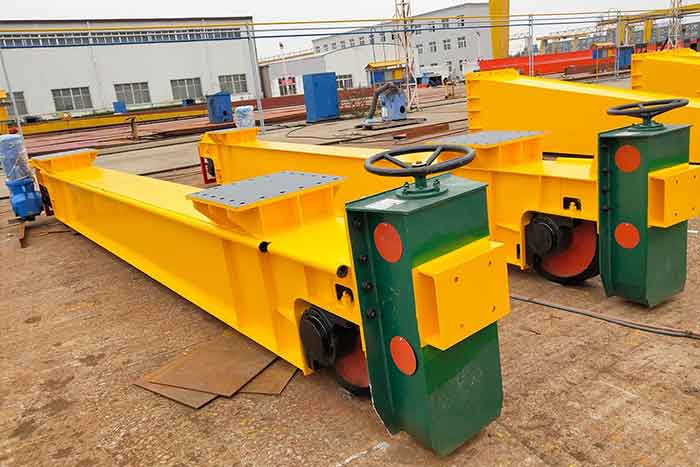
It is divided into three sections: the traveling assistance device, the driving device, and the safety device. The walking mechanism should be designed to ensure that the wheel pressures of the wheels under the same support legs are equal. To ensure uniform force on each running wheel, the trolley is an articulated balanced beam structure. Without an open gear transmission, one driving device only drives one driving wheel. Wind-proof anchoring device, track cleaner, and polyurethane buffer are included. Every two traveling wheels have wheel shaft break protection installed.
Mobile driver's cab

The driver’s cabin can be directly connected to the crane trolley and move together with the trolley via a special rigid support, avoiding collisions with stacks and spreaders.
Use enclosed toughened glass (heat preservation type). Its structural design takes into account not only various functional requirements, such as durability, safety, and dependability, but also a good view, comfort, and beauty, so that the driver feels comfortable during operation.
Crane power supply and trolley feed mode

Gantry crane power supply: high-voltage cable reel power supply
Trolley conductive: towline power supply
Electrical protection
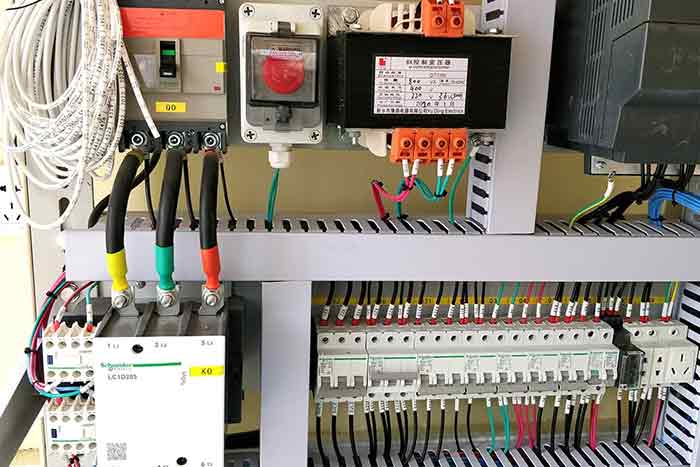
The main circuit breaker, main power contact, and overcurrent protection make up the power distribution system. Protection devices include short-circuit protection, over-current protection, loss-of-voltage protection, zero protection, ascending limit protection, stroke limit protection, emergency power-off protection, electrical interlocking protection device, overload load limiter, warning bell, anemometer, and Lightning rod,etc.
Platform & ladder
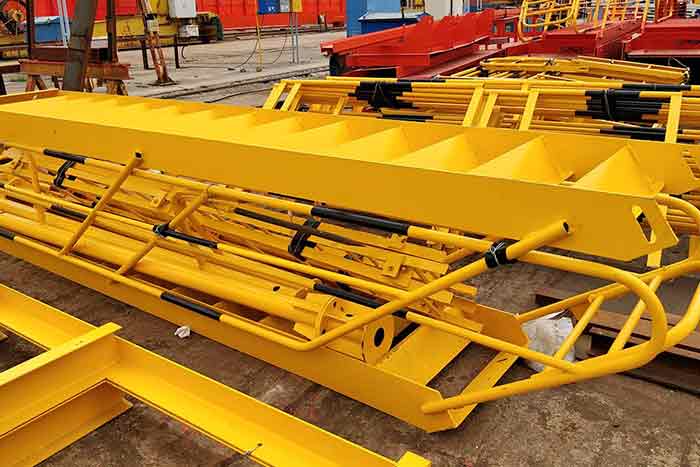
The crane ladder uses high-strength bolts join the major metal structural components. Ladders, platforms, walkway railings, and other components make up the associated steel framework.
Use 3mm thick checkered plates for ladder steps or platforms (or use galvanized steel gratings).
Container Spreader
The container spreader is chosen based on the type of containers that needs to be raised, and its design calls for simple replacement.

Container spreader
- Fully Automatic Spreaders -These top-lift spreaders include twist locks that lock on to the top of typical ISO containers and automatically activate.
- Semi Automatic Spreaders -The semi-automatic spreaders are designed to handle ISO containers of 10ft, 20ft, 40ft, and 45ft. Twist locks are mechanically activated by landing and lifting the spreader.
- Easy Spreaders -The easy spreaders are Ready for non-intensive use, which are suitable for all types of container handling for indoor and outdoor applications.
- Spreaders for Indoor Use-For indoor container handing, the indoor use container spreaders are suggested which are designed with the features of short wires or directly linked to the hook of the crane. They are optional with semi-automatic or manually operated.They are also suitable for all types of container handling.
Selection o f container gantry crane
The capacity of the terminal, collection and transportation methods, terminal road area, environmental protection, investment costs, and operating costs must all be taken into account when selecting a container gantry crane. If you are unsure which type of container gantry crane is best for your application, please provide the following basic information so we can assist you in making the right choice:
Types of container gantry crane you need:
- Rail Mounted Container Gantry Crane
- Rubber tyred container gantry crane?
Main specification of container cranes tailored to your application:
- What is the rated lifting capacity ?
- What is the span of the gantry crane?
- What is the lifting height of the container crane?
- What is the base distance?
Container Spreader for your cranes :
How to select the crane container spreader for your application? The following questions will help you to select the right one. Any question or problem, please feel free to contact us to leave a message below.
- How many containers do you lift a day?a) More than 100 – Intensive use.b) Less than 100 containers a day – Moderate use, c) Less than 10 times a day – Occasional use
- What type of containers do you usually handle?a) 40 ft ISO.b) 20 ft ISO.c) 40 & 20 ft ISO.d) Different to above.




